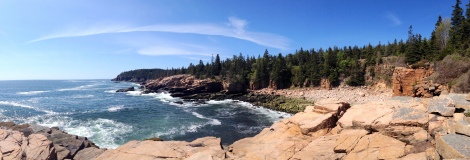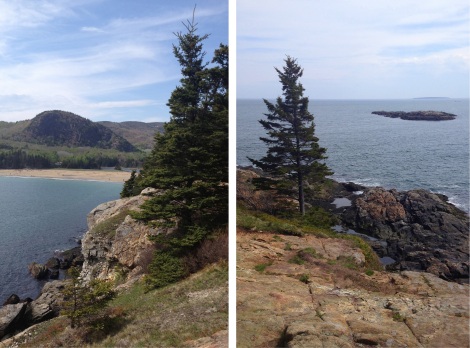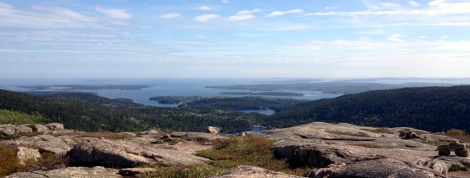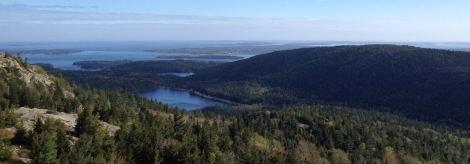It is worth noting that I would not describe myself as a particularly outdoorsy person. I don’t dislike the outdoors — in fact, I still occasionally consider running away to become a National Geographic correspondent — but these days, I’m generally happy to experience the wilderness from the safe and beautifully-composed distance of a nature documentary. As they say, the spirit is willing, but the flesh is weak and easily bug-bitten.
So I was initially a little dubious when I was invited to spend a week in Maine with my boyfriend and his family after the semester ended. They enjoy hiking and rock-climbing and generally being outside, whereas my most rugged hobby is getting lost in Boston. I wasn’t worried about being able to keep up, but I didn’t know whether I’d like hiking quite as much as they do…or, frankly, at all.
I had been hiking before, but those hikes were split between a) nature walks in Florida, where you walk over mostly-level and well-worn trails to get a better view of a swamp or marsh, and b) the Hidden Canyon trail in Zion National Park, which isn’t too strenuous and has incredible views, but is also extremely exposed. (As someone who hates open heights, I would probably pick the boring swamp over beautiful Hidden Canyon.) I understood conceptually why people liked hiking — wonderful scenery! physical activity! fresh air! — but to me, hiking meant either walking through a forest, or braving mortal peril in return for stunning views.
Turns out there’s actually a happy medium between nature walks and canyon walls, and that happy medium is mountains. Among other things, mountains have the wonderful property of sloping, so that even if you take a fall, it’s not five hundred feet into a chasm; they have really spectacular views; and they have markers at the summit, which makes you feel like you’ve accomplished something beyond just going for a complicated walk.
I may have been dubious at first, but after a semester spent indoors, a week’s worth of hiking up mountains and around lakes in Acadia National Park (and wandering around Bar Harbor, and stargazing, and sleeping, oh my god, sleeping) was precisely what the doctor ordered. I’ve climbed more mountains in the past week than I have in my entire life prior, but I also might just be a convert to this whole “going to interesting places the interesting way” thing.
We arrived in Bar Harbor on Sunday evening, but my introduction to hiking in Maine came on Monday, when we headed out to Sand Beach and then up to the Great Head trail. I was very glad that I was with experienced company — not because the hike was difficult, but because there’s a rock scramble a short ways into the hike and I hadn’t yet worked out how to read the blazes of paint that marked the trail. On my own, I would have made it as far as the rock scramble and then been stumped trying to figure out where on earth the trail went. (The answer, it turned out, was up the boulders that were in our way. Color me one baffled Floridian.)
Tuesday was similarly scrambly; we started out going for an afternoon walk on the carriage roads, then decided to veer off to a trail which follows the edge of Eagle Lake. The trail began as a smooth path, but quickly shifted to an extended scramble over big piles of granite boulders — this time I wasn’t the only one wondering where the trail had gone.
Despite being a little worried about what was lurking in the hollows between boulders (spiders? snakes? Gollum?), I enjoyed picking my way over the rocks…and stopping occasionally to take pictures of Eagle Lake and interesting lichens.
On Wednesday we were ready to try something more vertical, so we headed for the Bald Peak and Parkman Mountain loop. I was again a bit hesitant — Bald Peak and Parkman Mountain may be pretty short for mountains (only 974 and 941 feet tall, respectively), but they’re still mountains. I figured it probably wouldn’t end horribly, though, so I gamely followed along as we headed up Bald Peak, Mussorgsky thundering away in my head. The first third-ish of the trail wound through pine forest, but pretty soon that opened up into big granite slabs and alpine scrub as we headed up the peak.
When we made it to the top, I was introduced to my very favorite thing about mountains: the summit marker.  (That rectangular board at the top of the summit marker says “Bald Peak, Elev. 974’/297m.” The sun was behind it, so unfortunately all the pictures I took from the other side of the marker are 90% lens flare.)
(That rectangular board at the top of the summit marker says “Bald Peak, Elev. 974’/297m.” The sun was behind it, so unfortunately all the pictures I took from the other side of the marker are 90% lens flare.)
I don’t know why that marker made the mile-ish climb up Bald Peak feel like so much more of an accomplishment than the five-mile hike around Eagle Lake, but at the top of the mountain, I wasn’t about question it — I was content to catch my breath and admire the views of Upper and Lower Hadlock Pond on one side, and Somes Sound on the other.
After getting our fill of pictures, we headed down Bald Peak towards the summit of Parkman Mountain. Since the two summits are all of a thousand feet from each other, I figured it would be a pretty straightforward walk over to Parkman. Turns out that no, there’s actually quite a valley between the two; on the descent from Bald Peak, we climbed down twenty feet of rockfall at a time. It was a little tricky and a lot of fun, but I was very happy to be climbing down the boulders instead of up them.
The view from the top of Parkman is just about identical to the view from Bald Peak, but I was still happy to see another summit marker and take even more pictures. (The wind was mostly coming from the southeast that day, so Bald Peak acted as a windblock and made Parkman a slightly warmer place to rest.)
Neither mountain is particularly tall, but they both have fairly steep and scrambly ascents. That said, even as an absolute novice I didn’t find the climb notably strenuous — it certainly wasn’t a walk in the park, but the scrambles up granite ledges were intermixed with flatter portions that gave my legs a break.
There are both easier and harder ascents in Acadia, of course. On Thursday, we drove to the top of Cadillac Mountain (my calves didn’t complain at all!) and on Saturday, we climbed Dorr Mountain, the second-highest mountain in Acadia. There are four routes to the top, the best-known of which is the Ladder Trail, a steep and relatively exposed iron-rung route. We took the less intense South Ridge Trail instead, and even that nearly had me beat.
Unlike the climb up Bald Peak, which had scrambles mixed with flattish scrubby bits (that’s the technical term), Dorr was a grind the whole way — steep forest path just turned into steeper granite faces. Almost worse, the last few hundred feet to the summit were incredibly deceptive: the way the trees grow makes it look like the summit is permanently just fifty feet away. But eventually made it to the summit marker, and I swear the air up there tasted like victory.
Of course, the view from the top was wonderful, with Frenchman Bay and the Atlantic sprawled out on one side, and Eagle Lake and Jordan Pond on the other. It was especially cool to be able to see tiny Bar Harbor below us (if you zoom in, it’s just to the left of the cruise ship):
We climbed back down via the Gorge and the A. Murray Young Trail, and were halfway convinced we’d stumbled onto Middle-Earth. The Gorge is hundreds of feet of granite rockfall; none of the pictures I took do it justice, but it was an eternity of boulders piled upon boulders piled upon boulders. At some points, the boulders were so large that “hiking” became full-on “climbing.” If we had been climbing down at night — which I do not recommend, that’s a fantastic way to break a leg — I would not have been surprised at all if we found the doors to Moria glowing faintly on the granite walls of the Gorge.
The Gorge eventually connects to the A. Murray Young Trail, which is an impossibly tranquil path. The trail follows a small stream which dives down the slabs of granite and shale in the form of tiny waterfalls. The trees on this part of the mountain are mostly birch forest, and in the mid-afternoon, the light streams down onto the birch leaves, turning them a vibrant green and throwing dappled shadows onto the trail. It’s breathtaking, and after the arduous hike up Dorr Mountain, taking this jewel of a trail on the way down was just lovely.
On our last day, we were going to make one final short hike up to the top of Flying Mountain; though it’s only 284 feet above sea level, it has amazing views of Somes Sound and Valley Cove. Unfortunately, the trail back from Flying Mountain is closed during the summer to protect peregrine falcon nesting sites. None of us had any interest in being dive-bombed by territorial falcons, so we ended up walking part of the beautiful Ocean Path instead, heading from Otter Cliffs to Monument Cove and back — certainly no loss in terms of amazing views. (We were planning to go out to Thunder Hole, but it turns out that walking along the shore until you find a place where the waves sound thunder-y is not a good way of identifying landmarks. Who knew.)

After we left Monument Cove, we finished off the morning with pancakes at a cafe in Bar Harbor, without a doubt the best blueberry pancakes I’ve ever had. Then it was time to make our way back to the real world, where the ocean isn’t as blue and the night sky isn’t as beautiful…but at least there’s no rockfall to climb over on the way to class.
Ah, who am I kidding? I won’t be signing up for a Kilimanjaro trek anytime soon, but I can’t wait for my next chance to hike up pretty rocks. Some places are wonderful enough to be worth braving a few bug bites. I’m already making a list.










